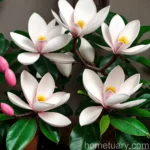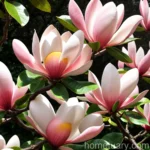The Star Magnolia (Magnolia stellata): A Comprehensive Guide
Welcome to our comprehensive guide on the star magnolia (Magnolia stellata). In this article, we will delve into the characteristics, care, propagation, and all you need to know about this stunning plant. Whether you’re a seasoned gardener or just starting your journey in plant cultivation, this guide will provide valuable insights into the world of star magnolias.
What is the Star Magnolia (Magnolia stellata)?
The star magnolia, scientifically known as Magnolia stellata, is a beautiful deciduous shrub or small tree belonging to the Magnoliaceae family. Native to Japan, this plant is cherished for its elegant, star-shaped flowers that adorn its branches in early spring. The star magnolia is an excellent choice for landscape enhancement, adding a touch of grace and beauty to any garden or outdoor space.
Magnolia stellata Characteristics
Before diving into the care and cultivation of star magnolias, it’s essential to understand the key characteristics of this plant:
-
Flowers: The star magnolia produces large, fragrant, white or pale pink flowers with a distinctive star-like shape. These flowers typically have 12-18 narrow petals, creating a captivating visual display.
-
Foliage: The leaves of Magnolia stellata are alternate, simple, and obovate in shape. They are glossy green in color, turning to a delicate yellow hue in the fall, adding seasonal interest to the landscape.
-
Size: Star magnolias are relatively compact, typically reaching a height of 15-20 feet and a spread of 10-15 feet, making them suitable for small gardens or as an understory planting in larger landscapes.
-
Growth Habit: The growth habit of the star magnolia is multi-stemmed, and its overall form tends to be rounded and bushy, creating a charming silhouette in the garden.
With these characteristics in mind, let’s explore the various aspects of caring for and cultivating star magnolias.
Key Takeaways – Star Magnolia (Magnolia stellata)
Culture
Cultivating the star magnolia involves understanding its specific cultural requirements, including its preferred climate, soil conditions, and other environmental factors.
Uses
The star magnolia serves multiple purposes in garden landscapes, from being an ornamental focal point to providing seasonal interest and fragrance.
Water
Understanding the water needs of the star magnolia is crucial for maintaining its health and promoting optimal growth and flowering.
Sunlight
Proper sunlight exposure is essential for the star magnolia to thrive and produce an abundance of beautiful flowers.
Fertilizer
Applying the right type and amount of fertilizer is critical for ensuring the nutrient uptake and overall health of the star magnolia.
Soil
Creating the ideal soil environment is key to supporting the growth and development of star magnolias, promoting strong root systems and lush foliage.
Pruning
Pruning practices play a significant role in shaping the growth of the star magnolia and maintaining its overall health and appearance.
Propagation
Exploring various methods of propagating star magnolias allows for the expansion of their presence in the garden and landscape.
Container Popularity
Understanding the potential for growing star magnolias in containers opens up new possibilities for urban and small-space gardening.
Common Diseases
Recognizing and addressing common diseases that affect star magnolias is crucial for preserving their beauty and vitality.
Disease Diagnosis
Being able to diagnose and treat diseases promptly is essential for managing the health of star magnolias in garden settings.
Common Pests
Identifying and controlling common pests helps protect star magnolias from potential damage and stress.
Botanist’s Tips
Insightful tips from botanists and experienced gardeners can offer valuable guidance for successfully growing and caring for star magnolias.
Fun Facts
Exploring interesting and little-known facts about star magnolias adds to the fascination and appreciation of these captivating plants.
Now, let’s delve into each of these key takeaways to gain a comprehensive understanding of star magnolia care and cultivation.
Culture
Preferred Climate
Star magnolias thrive in temperate climates, favoring regions with well-defined seasons. They are well-suited to USDA hardiness zones 4-8, where they can experience the necessary winter chill for dormancy and the ideal warmth for spring flowering.
Temperature Tolerance
While star magnolias appreciate a period of winter dormancy, they are sensitive to late frost, which can damage the delicate blossoms. Therefore, planting in a location with some protection from late spring frosts is advisable.
Growth Rate
The growth rate of star magnolias can be considered moderate, with steady annual growth when provided with the proper care and conditions. While not rapid growers, these plants exhibit consistent and reliable growth under favorable circumstances.
Uses
The star magnolia has several remarkable uses in garden landscapes:
-
Ornamental Features: The plant serves as an ornamental focal point, especially during the spring flowering season when its star-shaped blossoms create a stunning display.
-
Seasonal Interest: In addition to its striking spring flowers, star magnolias offer year-round appeal, with lush green foliage in the summer and attractive yellow fall color.
-
Fragrance: The flowers of star magnolias emit a delightful fragrance, adding an olfactory element to garden landscapes.
-
Wildlife Habitat: The plant may attract pollinators such as bees and butterflies, contributing to the biodiversity and ecological balance of the garden.
-
Cut Flower Arrangements: The exquisite blossoms of star magnolias make for beautiful cut flower arrangements, bringing the joy of spring indoors.
-
Specimen Planting: Planted individually or in small groups, star magnolias can function as specimen plants, drawing attention and admiration in the landscape.
With its versatility and aesthetic appeal, the star magnolia is a valuable addition to any garden setting.
Water
Watering Frequency
In general, star magnolias prefer consistently moist soil, especially during periods of active growth and flowering. Regular watering, particularly during dry spells, will help maintain adequate soil moisture levels and support the plant’s vitality.
Watering Techniques
When watering star magnolias, it’s important to apply water directly to the root zone, ensuring thorough penetration and absorption by the root system. Avoid overhead watering, as this can lead to foliar diseases and may not effectively reach the root area.
Drought Tolerance
While star magnolias appreciate consistent moisture, they do exhibit some tolerance to brief periods of drought. However, extended dry conditions can stress the plant and impact its overall health and flowering capacity. Therefore, regular monitoring of soil moisture levels is recommended.
Watering Schedule
Establishing a regular watering schedule, especially during dry or hot periods, can help support the growth and flowering of star magnolias. Adjust the frequency of watering based on weather conditions and the moisture retention of the soil.
Water Quality
Providing quality water that is free from harmful chemicals and excessive salts is critical for the health of star magnolias. Consider using rainwater or filtered water when possible to avoid potential issues associated with poor water quality.
Sunlight
Sun Exposure
Star magnolias thrive in locations with partial shade to full sun, although they generally prefer a more sheltered site with filtered sunlight. Full sun exposure can be suitable in cooler climates, while partial shade is beneficial in hotter regions.
Optimal Sunlight Conditions
Providing the ideal balance of sunlight is crucial for the overall health and floral potential of star magnolias. Aim for a location that receives morning sun and afternoon shade, especially in areas with hot summers, to prevent stress and sunburn on the foliage.
Sunlight Requirements
Understanding the specific sunlight requirements of star magnolias is essential for selecting appropriate planting locations and ensuring their long-term success. Consider the following when assessing sunlight conditions for these plants:
-
Morning vs. Afternoon Sun: The timing of sunlight exposure can impact the plant’s ability to photosynthesize efficiently without being subjected to excessive heat stress.
-
Filtered Light: The dappled, filtered light in a woodland setting can mimic the natural habitat of star magnolias, providing an ideal environment for their growth and flowering.
-
Tolerances: While star magnolias appreciate shelter from intense afternoon sun, they do require a sufficient amount of light to support flowering and overall vigor.
-
Seasonal Variations: Be mindful of potential changes in sunlight exposure as deciduous trees nearby undergo seasonal leaf changes, which can affect the amount and quality of light reaching the star magnolia.
Striking the right balance with sunlight exposure plays a pivotal role in the successful cultivation of star magnolias.
Fertilizer
Nutrient Requirements
Star magnolias benefit from regular applications of a balanced, slow-release fertilizer formulated for acid-loving plants. Choosing a fertilizer with a balanced NPK ratio and micronutrients specific to the needs of magnolias can provide the necessary nutrition for optimal growth and flowering.
Fertilizer Application
Apply fertilizer to star magnolias in early spring before the onset of new growth, ensuring even distribution around the root zone. Avoid direct contact with the trunk or foliage, as this may lead to nutrient burn and other potential issues.
Frequency of Fertilization
A yearly application of fertilizer in spring is generally sufficient to meet the nutritional needs of star magnolias. However, if the plant shows signs of nutrient deficiencies, such as yellowing leaves or reduced vigor, a second application during midsummer may be beneficial.
Organic Fertilizers
Organic fertilizers, such as compost, well-rotted manure, or organic blends specifically designed for acid-loving plants, can offer a natural and sustainable approach to meeting the nutrient requirements of star magnolias. These organic amendments contribute to soil health and fertility over time.
Avoiding Overfertilization
Exercise caution to avoid overfertilization, as this can lead to excessive vegetative growth, reduced flowering, and potential stress on the plant. Adhere to the recommended application rates and guidelines provided by the fertilizer manufacturer.
Soil
Soil Type
Star magnolias thrive in well-draining, acidic soil with a preference for a pH range of 5.0-6.5. The ability of the soil to retain moisture while allowing excess water to drain away is crucial for the health and vitality of these plants.
Soil Structure
A loose, loamy soil structure that is rich in organic matter provides an ideal growing medium for star magnolias. This type of soil promotes healthy root development and supports the efficient uptake of nutrients and water.
Soil Amendments
Incorporating organic matter, such as compost, leaf mold, or well-rotted pine bark, into the soil can improve its structure, fertility, and overall quality. These amendments also contribute to the maintenance of acidic conditions favored by star magnolias.
Mulching
Applying a layer of organic mulch around the base of star magnolias helps conserve soil moisture, regulate soil temperature, and suppress weed growth. Additionally, as the mulch breaks down, it contributes organic matter to the soil, enhancing its fertility and texture.
Proper Drainage
Ensuring proper drainage in the planting area is crucial for preventing waterlogged conditions, which can be detrimental to the health and survival of star magnolias. Avoid locations prone to water accumulation or stagnant, poorly drained soil.
Pruning
Pruning Objectives
Pruning star magnolias serves several objectives, including:
-
Shaping: Pruning can help maintain the desired form and structure of the plant, creating an appealing silhouette in the garden.
-
Health: Removal of dead, damaged, or diseased branches can promote overall plant health and vitality.
-
Flowering: Proper pruning can encourage the development of flowering wood, leading to abundant and well-distributed blossoms.
-
Size Control: Pruning can manage the size of star magnolias, preventing overcrowding and maintaining a balanced appearance.
Pruning Time
The best time to prune star magnolias is after flowering, typically in late spring or early summer. Pruning at this time allows the plant to recover and set buds for the following year’s blossoms without disrupting the flowering cycle.
Pruning Techniques
When pruning star magnolias, employ the following techniques to achieve the desired results:
-
Selective Pruning: Target specific branches for removal to enhance the plant’s overall form and structure.
-
Thinning: Thinning out excessive growth can improve air circulation and light penetration, reducing the risk of disease and promoting uniform flowering.
-
Deadheading: Remove spent flowers to encourage additional bud set and prevent the energy expenditure of seed production.
-
Training: Direct the growth of young branches to promote an open, well-spaced framework that supports healthy growth and flowering.
Pruning Tools
Utilize sharp, clean pruning tools, such as hand pruners, loppers, and pruning saws, to ensure precision and minimize damage to the plant. Sterilize tools between cuts, especially if pruning diseased branches, to prevent the spread of pathogens.
Pruning Best Practices
When engaging in pruning activities, adhere to the following best practices to maximize the benefits and minimize the potential risks:
-
Prune Conservatively: Avoid over-pruning, as excessive removal of branches can weaken the plant and disrupt its natural growth habit.
-
Sanitation: Dispose of pruned material properly, and if removing diseased branches, carefully clean and sterilize pruning tools to prevent the spread of diseases.
-
Consultation: When in doubt about pruning practices or the extent of pruning necessary, seek guidance from experienced gardeners or horticultural professionals.
Propagation
Propagation Methods
Several methods can be used to propagate star magnolias, allowing for the expansion of their presence in the garden and landscape:
-
Seed Propagation: Sowing seeds collected from mature star magnolia fruits can be an effective way to grow new plants, although it may take several years for seedlings to reach flowering maturity.
-
Softwood Cuttings: Taking softwood cuttings from actively growing shoots in early summer and rooting them under controlled conditions can produce genetically identical clones of the parent plant.
-
Air Layering: Encouraging the development of roots on a stem while still attached to the parent plant, then separating the rooted section to form a new plant, is another viable method of propagation.
-
Grafting: Joining a desired star magnolia cultivar onto a compatible rootstock can yield plants with specific characteristics or improve the overall vigor and adaptability of the grafted specimen.
Propagation Considerations
When propagating star magnolias, consider the following factors to ensure successful establishment and growth of new plants:
-
Timing: Timing propagation activities to coincide with the plant’s natural growth and reproductive cycles can improve the likelihood of success.
-
Environmental Conditions: Providing the appropriate environmental conditions, such as consistent moisture, warmth, and humidity, can support the rooting and establishment of propagated plants.
-
Genetic Variation: Remember that seed-propagated plants may exhibit genetic variation, potentially leading to variability in flower color, size, or habit.
-
Rooting Hormones: Using rooting hormones or other rooting aids can enhance the success rate of propagation, especially for cuttings and air layering methods.
-
Propagation Materials: Ensure the use of high-quality propagation materials, such as well-draining rooting medium and disease-free cuttings or seeds, to optimize the propagation process.
Container Propagation
Engaging in propagation within containers can offer a practical and manageable approach, especially for home gardeners or those with limited garden space. The controlled environment provided by containers allows for close monitoring and care of propagated plants.
Container Popularity
Benefits of Container Cultivation
Growing star magnolias in containers offers several advantages, making them popular choices for urban and small-space gardening:
-
Space Adaptability: Container-grown star magnolias can thrive on patios, balconies, or small outdoor spaces, expanding the possibilities for growing these plants in urban environments.
-
Portability: The mobility of container-grown specimens allows for easy relocation, making it convenient to position them for optimal sunlight, protection from harsh weather, or aesthetic considerations.
-
Soil Control: Container cultivation provides greater control over the soil conditions, enabling the use of specific potting mixes tailored to the preferences of star magnolias.
-
Landscape Diversity: Incorporating container-grown star magnolias into garden landscapes adds dimension, versatility, and the opportunity to create seasonal focal points through strategic positioning.
-
Overwintering: Containers can be moved indoors or to sheltered locations during the winter, protecting the plants from extreme cold and minimizing potential frost damage.
Container Selection
When choosing containers for star magnolias, consider the following aspects to ensure the favorable growth of the plants:
-
Size: Select containers that accommodate the current root size of the plant, with adequate room for root development and future growth.
-
Drainage: Ensure that containers have sufficient drainage holes to prevent waterlogging and promote healthy root conditions.
-
Material: Durable, weather-resistant materials such as fiberglass, concrete, or high-quality plastic are suitable for long-term container cultivation.
-
Insulation: Consider using insulated containers or adding protective wraps during the winter to shield the roots from freezing temperatures.
Container Maintenance
Providing routine care and maintenance for container-grown star magnolias is crucial for their well-being and longevity. Focus on the following key aspects of container cultivation:
-
Watering: Monitor soil moisture levels regularly and adjust watering frequency to account for fluctuating environmental conditions and seasonal changes.
-
Fertilization: Apply a balanced, slow-release fertilizer specially formulated for container plants to support the nutrient needs of star magnolias.
-
Repotting: Periodically assess the rootbound status of container-grown plants and repot them into larger containers to maintain healthy root systems and prevent overcrowding.
-
Winter Protection: Take appropriate measures to protect container-grown star magnolias from the potential impacts of winter weather, such as freezing temperatures and desiccating winds.
Growing star magnolias in containers offers a unique and rewarding way to enjoy these exquisite plants in a variety of garden settings.
Common Diseases
Fungal Diseases
Star magnolias can be susceptible to various fungal diseases that may affect their overall health and flowering potential. Key fungal issues to be aware of include:
-
Powdery Mildew: This common fungal disease appears as a powdery white coating on the leaves and young shoots, often caused by poor air circulation and high humidity.
-
Anthracnose: Anthracnose can cause brown or black lesions on the leaves, leading to defoliation and reduced vitality if left unchecked.
-
Leaf Spot Diseases: Various leaf spot fungi can cause small to large dark spots on the foliage, potentially impacting the plant’s aesthetic appeal and photosynthetic capacity.
Bacterial Diseases
In addition to fungal diseases, star magnolias may be susceptible to certain bacterial issues, such as:
-
Bacterial Blight: Characterized by dark or water-soaked lesions on leaves and stems, bacterial blight can result in rapid wilting and dieback of affected plant parts.
-
Bacterial Canker: The presence of cankers—sunken, discolored areas on branches and stems—indicates the potential activity of bacterial canker, which can lead to reduced vigor and dieback.
Disease Management
Implementing proactive disease management practices can help safeguard the health and resilience of star magnolias. Consider the following strategies for disease prevention and control:
- Cultural Practices: Promote good air circulation, maintain proper spacing between plants, and avoid overhead irrigation to reduce humidity and minimize conditions favorable for disease development.















